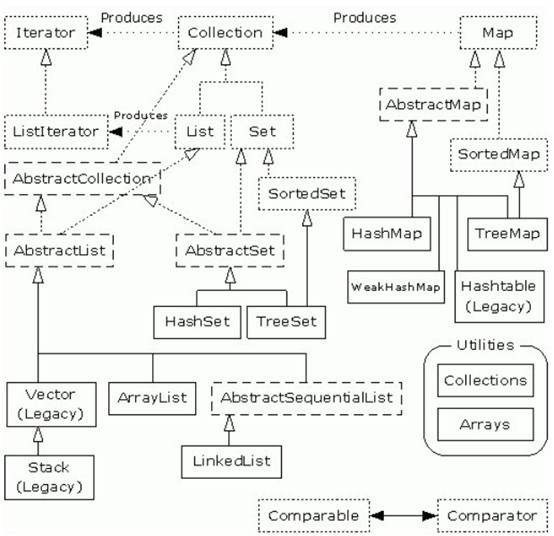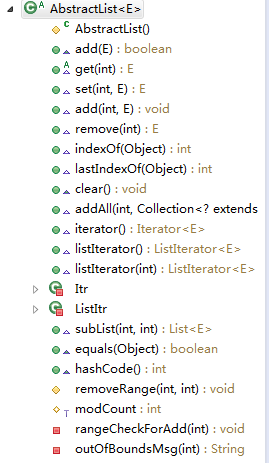不积跬步,无以至千里;不积小流,无以成江海。从基础做起,一点点积累,加油!
来,首先看一下Java集合类的父子关系(图片转自:http://biancheng.dnbcw.info/1000wen/359774.html):
ArrayList的定义
public class ArrayList<E> extends AbstractList<E>implements List<E>, RandomAccess, Cloneable, java.io.Serializable- 从ArrayList<\E>可以看出它是支持泛型的,它继承自AbstractList,实现了List、RandomAccess、Cloneable、java.io.Serializable接口。
Collection接口的方法:
List:
定义
public interface List<E> extends Collection<E>List接口方法:
AbstractList提供了List接口的默认实现(个别方法为抽象方法(get方法))。
public abstract class AbstractList<E> extends AbstractCollection<E> implements List<E>//ArrayList中使用的modCount就是AbstractList中声明的
protected transient int modCount = 0;AbstractList中对于List集合的判断equals()方法
public boolean equals(Object o) {
if (o == this)
return true;
if (!(o instanceof List))
return false;
ListIterator<E> e1 = listIterator();
ListIterator<?> e2 = ((List<?>) o).listIterator();
while (e1.hasNext() && e2.hasNext()) {
E o1 = e1.next();
Object o2 = e2.next();
if (!(o1==null ? o2==null : o1.equals(o2)))
return false;
}
return !(e1.hasNext() || e2.hasNext());
}这个方法我觉得写得特别好,放在这里留着。。。
- AbstractList继承了AbstractCollection类,实现了List集合的除了get方法之外的所有方法:
- RandomAccess是一个标记接口,接口内没有定义任何内容。
- 实现了Cloneable接口的类,可以调用Object.clone方法返回该对象的浅拷贝。
- 通过实现 java.io.Serializable 接口以启用其序列化功能。未实现此接口的类将无法使其任何状态序列化或反序列化。序列化接口没有方法或字段,仅用于标识可序列化的语义。
ArrayList的数据域
transient Object[] elementData; // non-private to simplify nested class access
/**
* The size of the ArrayList (the number of elements it contains).
*/
private int size;transient 关键字
- Java的Serializable提供了一种序列化对象实例的机制。当序列化对象时,可能有一个特殊的对象数据成员,我们不想用Serializable机制来保存它。为了在一个特定对象的一个域上关闭Serializable,可以在这个域前加上关键字transient。
- transient是Java语言的关键字,用来表示一个域不是该对象序列化的一部分。当一个对象被序列化的时候,transient型变量的值不包括在序列化的表示中,然而非transient型的变量是被包括进去的。
看个列子:
public class Person implements Serializable{
private static final long serialVersionUID = -3319659493471806232L;
private String name;
private transient String pass;
public Person(String name, String pass) {
this.name = name;
this.pass = pass;
}
@Override
public String toString() {
return "Person [name=" + name + ", pass=" + pass + "]";
}
}
public class TestTransient {
public static void main(String[] args) {
Person person = new Person("Tome", "1234");
System.out.println(person);
try {
// 序列化,被设置为transient的属性没有被序列化
ObjectOutputStream o = new ObjectOutputStream(new FileOutputStream(
"person.out"));
o.writeObject(person);
o.close();
} catch (Exception e) {
e.printStackTrace();
}
try {
// 重新读取内容
ObjectInputStream in = new ObjectInputStream(new FileInputStream(
"person.out"));
Person readPerson = (Person) in.readObject();
// 读取后psw的内容为null
System.out.println(readPerson.toString());
} catch (Exception e) {
e.printStackTrace();
}
}
}
/**运行结果
*Person [name=Tome, pass=1234]
*Person [name=Tome, pass=null]
*/被标记为transient的属性在对象被序列化的时候不会被保存。
构造方法分析
private static final Object[] DEFAULTCAPACITY_EMPTY_ELEMENTDATA = {};
private static final Object[] EMPTY_ELEMENTDATA = {};
public MyArrayList() {
this.elementData = DEFAULTCAPACITY_EMPTY_ELEMENTDATA;
}
public MyArrayList(int initialCapacity) {
if (initialCapacity > 0) {
this.elementData = new Object[initialCapacity];
} else if (initialCapacity == 0) {
this.elementData = EMPTY_ELEMENTDATA;
} else {
throw new IllegalArgumentException("Illegal Capacity: "
+ initialCapacity);
}
}
public ArrayList(Collection<? extends E> c) {
elementData = c.toArray();
if ((size = elementData.length) != 0) {
// c.toArray might (incorrectly) not return Object[] (see 6260652)
if (elementData.getClass() != Object[].class)
elementData = Arrays.copyOf(elementData, size, Object[].class);
} else {
// replace with empty array.
this.elementData = EMPTY_ELEMENTDATA;
}
}三个构造方法:
- 无参构造方法
- 使用无参构造方法创建的是一个length为0的内部数组,当第一次插入数据时,会对其扩容,扩容为默认的大小10
- 带有初始容量的构造方法
- 创建一个默认容量的数组
- 带有初始集合的构造方法
add(E e)方法
public boolean add(E e) {
ensureCapacityInternal(size + 1); // 检查是否需要扩容
elementData[size++] = e;
return true;
}
private void ensureCapacityInternal(int minCapacity) {
//如果创建ArrayList时用的是无参构造器,则第一次插入时会进行一次扩容并且扩到默认数组大小10
//然而如果是使用带有容量参数的构造器且initialCapacity=0时,则不会进行这一步,直接扩展数组容量为minCapacity
//这就导致一个结果,扩容之后带参数的构造器的数组length为1,而默认的为10
//所以,带容量参数的初始化时注意自己需要的大小
if (elementData == DEFAULTCAPACITY_EMPTY_ELEMENTDATA) {
minCapacity = Math.max(DEFAULT_CAPACITY, minCapacity);
}
ensureExplicitCapacity(minCapacity);
}
private void ensureExplicitCapacity(int minCapacity) {
modCount++;
// overflow-conscious code
if (minCapacity - elementData.length > 0)
grow(minCapacity);
}
private void grow(int minCapacity) {
// overflow-conscious code
int oldCapacity = elementData.length;
int newCapacity = oldCapacity + (oldCapacity >> 1);
if (newCapacity - minCapacity < 0)
newCapacity = minCapacity;
if (newCapacity - MAX_ARRAY_SIZE > 0)
newCapacity = hugeCapacity(minCapacity);
// minCapacity is usually close to size, so this is a win:
elementData = Arrays.copyOf(elementData, newCapacity);
}容量的拓展将导致数组元素的复制,多次拓展容量将执行多次整个数组内容的复制。若提前能大致判断list的长度,调用ensureCapacity调整容量,将有效的提高运行速度。
可以理解提前分配好空间可以提高运行速度,但是测试发现提高的并不是很大,而且若list原本数据量就不会很大效果将更不明显。
add(int index, E element)
public void add(int index, E element) {
rangeCheckForAdd(index);//检查index是否越界
ensureCapacityInternal(size + 1); // 确保容量
System.arraycopy(elementData, index, elementData, index + 1,//将index以后的元素后移一个
size - index);
elementData[index] = element;
size++;
}
private void rangeCheckForAdd(int index) {
if (index > size || index < 0)//元素可以添加在最后尾端
throw new IndexOutOfBoundsException(outOfBoundsMsg(index));
}
//本地的C/C++库方法,直接操纵内存,速度更快
public static native void arraycopy(Object src, int srcPos,
Object dest, int destPos,
int length);indexOf(Object o)
public int indexOf(Object o) {
if (o == null) {
for (int i = 0; i < size; i++)
if (elementData[i]==null)
return i;
} else {
for (int i = 0; i < size; i++)
if (o.equals(elementData[i]))
return i;
}
return -1;
}remove(int index)
public E remove(int index) {
rangeCheck(index);//检查是否越界
modCount++;
E oldValue = elementData(index);
int numMoved = size - index - 1;
if (numMoved > 0)
System.arraycopy(elementData, index+1, elementData, index,
numMoved);
elementData[--size] = null; // 将对象的引用置为null,让垃圾回收器可以回收
return oldValue;
}
//删除等其他操作和插入不同,插入可以将元素插在最后面,而删除等操作是在原有的元素上做修改,所以范围检查不一样
private void rangeCheck(int index) {
if (index >= size)
throw new IndexOutOfBoundsException(outOfBoundsMsg(index));
}clear()
public void clear() {
modCount++;
// 清空让垃圾回收器清理
for (int i = 0; i < size; i++)
elementData[i] = null;
size = 0;
}clone()
返回此 ArrayList 实例的浅表副本。(不复制这些元素本身。)
public Object clone() {
try {
ArrayList<?> v = (ArrayList<?>) super.clone();
v.elementData = Arrays.copyOf(elementData, size);
v.modCount = 0;
return v;
} catch (CloneNotSupportedException e) {
// this shouldn't happen, since we are Cloneable
throw new InternalError(e);
}
}调用父类的clone方法返回一个对象的副本,将返回对象的elementData数组的内容赋值为原对象elementData数组的内容,将副本的modCount设置为0。
removeRange(int fromIndex, int toIndex)
protected void removeRange(int fromIndex, int toIndex) {
modCount++;
int numMoved = size - toIndex;
System.arraycopy(elementData, toIndex, elementData, fromIndex,
numMoved);
// clear to let GC do its work
int newSize = size - (toIndex-fromIndex);
for (int i = newSize; i < size; i++) {
elementData[i] = null;
}
size = newSize;
}执行过程是将elementData从toIndex位置开始的元素向前移动到fromIndex,然后将toIndex位置之后的元素全部置空顺便修改size。
ArrayList<Person> arrayList = new ArrayList<Person>();
arrayList.add(new Person(2));
arrayList.add(new Person(3));
arrayList.add(new Person(4));
arrayList.add(new Person(5));
arrayList.add(new Person(6));
arrayList.subList(2, 4).clear();上面这段代码的运行结果与removeRange(2, 4)一样,原因是:
arrayList.subList(2, 4)创建一个AbstractList的子类SubList的实例,调用clear方法时由于子类SubList没有重写,所以直接调用AbstractList的clear方法,然而,在AbstractList的clear方法中,调用的是removeRange方法,该方法在SubList中重写了;所以,调用的是子类的removeRange,在SubList中有一个指向外部类的指针parent,在removeRange方法中通过parent调用了外部类的removeRange方法。所以经过辗转调用,最终调用的还是外部类的removeRange方法
public List<E> subList(int fromIndex, int toIndex) {
subListRangeCheck(fromIndex, toIndex, size);
return new SubList(this, 0, fromIndex, toIndex);
}
//SubList类中没有重写AbstractList的clear方法
private class SubList extends AbstractList<E> implements RandomAccess {
private final AbstractList<E> parent;//指向外部类
private final int parentOffset;
private final int offset;
int size;
SubList(AbstractList<E> parent,
int offset, int fromIndex, int toIndex) {
this.parent = parent;
this.parentOffset = fromIndex;
this.offset = offset + fromIndex;
this.size = toIndex - fromIndex;
this.modCount = ArrayList.this.modCount;
}
...
protected void removeRange(int fromIndex, int toIndex) {
checkForComodification();
parent.removeRange(parentOffset + fromIndex,parentOffset + toIndex);
//调用外部类的removeRange(),所以最终修改的就是外部类数组的元素,即相当于调用了外部类的removeRange方法
this.modCount = parent.modCount;
this.size -= toIndex - fromIndex;
}
}
//AbstractList类中申明的clear()方法
public void clear() {
removeRange(0, size());//由于SubList重写了removeRange方法,所以调用SubList的removeRange方法,
}每一次对数组做添加元素,删除元素等改变数组大小或者容量的操作时都会引起对modCount的加1, 究竟这个值有什么作用呢?
//返回一个遍历的指针
public Iterator<E> iterator() {
return new Itr();
}
private class Itr implements Iterator<E> {
int cursor; // 下一个要返回的元素的下标
int lastRet = -1; // 最后一个元素的下标
int expectedModCount = modCount; //这个的作用就是当用itr来遍历集合时,不允许往里面添加或者删除元素
public boolean hasNext() {//hasNext方法不会检查expectedModCount 的值,不会引发ConcurrentModificationException异常
return cursor != size;
}
@SuppressWarnings("unchecked")
public E next() {//next方法在最开始的时候就会使用checkForComodification进行检查
//所以如果在调用next之前对集合进行了改变则会抛出异常
checkForComodification();//检查是否改变
int i = cursor;
if (i >= size)
throw new NoSuchElementException();
Object[] elementData = MyArrayList.this.elementData;
if (i >= elementData.length)
throw new ConcurrentModificationException();
cursor = i + 1;
return (E) elementData[lastRet = i];
}
//remove方法首先会调用checkForComodification进行检查
//同时,在MyArrayList.this.remove(lastRet)时会改变modCount,expectedModCount = modCount
//又让情况变为正常,所以删除之后这两个的值又会想等,在之后调用next的方法时不会炮竹异常
public void remove() {
if (lastRet < 0)
throw new IllegalStateException();
checkForComodification();
try {
MyArrayList.this.remove(lastRet);
cursor = lastRet;
lastRet = -1;
expectedModCount = modCount;
} catch (IndexOutOfBoundsException ex) {
throw new ConcurrentModificationException();
}
}
@SuppressWarnings("unchecked")
public void forEachRemaining(Consumer<? super E> consumer) {
Objects.requireNonNull(consumer);
final int size = MyArrayList.this.size;
int i = cursor;
if (i >= size) {
return;
}
final Object[] elementData = MyArrayList.this.elementData;
if (i >= elementData.length) {
throw new ConcurrentModificationException();
}
while (i != size && modCount == expectedModCount) {
consumer.accept((E) elementData[i++]);
}
// update once at end of iteration to reduce heap write traffic
cursor = i;
lastRet = i - 1;
checkForComodification();
}
final void checkForComodification() {
if (modCount != expectedModCount)
throw new ConcurrentModificationException();
}
}ArrayList的三种遍历
- 使用下标(在遍历的时候可以对集合进行添加删除)
MyArrayList<Integer> array = new MyArrayList<Integer>();
array.add(1);
array.add(2);
array.add(1, 3);
array.display();
for(int i = 0; i < array.size(); i++){
System.out.println(array.get(i));
array.remove(new Integer(3));
if (i == 1) {
array.add(1);
}
}- 使用iterator
Iterator<Integer> it = array.iterator();
while(it.hasNext()){
//array.add(4); 会导致modCount发生变化,从而导致next方法的checkModCount抛出异常
int value = it.next();
//array.remove(new Integer(value));同样会导致modCount发生变化
it.remove();//但是可以这样,因为Iterator的remove方法删除元素之后对modCount又进行了复原
System.out.println(value);
}- 使用forEach循环(其实本质就是利用的Iterator循环)先是it.hasNext(),然后在将value = it.next(),所以执行这段代码时,会先打印第一个值,在进行第二轮循环的value = it.next()时抛出异常
for(Integer value : array){
//array.add(4);//发生错误
//array.remove(value);
System.out.println(value);
}本文参考:http://www.cnblogs.com/hzmark/archive/2012/12/20/ArrayList.html
今天看了大牛的代码很开心,明天再接再厉,加油。感受大牛的风采~~


























 1652
1652











 被折叠的 条评论
为什么被折叠?
被折叠的 条评论
为什么被折叠?








